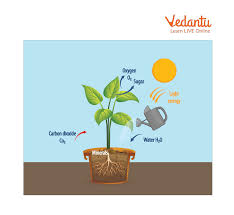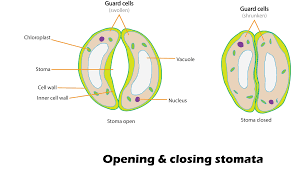Why is Respiration Vital for Plants?
Plant respiration is the key process that enables plants to convert the sugars (produced via photosynthesis) into usable energy. While it might be tempting to think that only animals need respiration, plants, too, respire continuously. From respiration in plants class 7 up to advanced studies like respiration in plants class 11 or higher, students learn that this phenomenon is crucial to maintain every plant function—right from transporting nutrients to repairing tissues.
In simple terms, plant respiration utilises oxygen to break down glucose and release carbon dioxide, water, and energy. This fundamental step is essential for growth, reproduction, and overall survival. Whether you are studying respiration in plants class 10 or exploring higher-level biology, understanding respiration helps appreciate the delicate balance between photosynthesis and energy release.

Plant Respiration Takes Place Continuously
A common question is whether respiration in plants takes place in day or night. The straightforward answer is: it happens both during the day and at night. However, it is most noticeable after sunset because photosynthesis slows or stops without sunlight, making the release of carbon dioxide more apparent. Hence, plant respiration at night is often emphasised because plants then mainly emit CO₂ (rather than taking it in for photosynthesis).
The Plant Respiration Equation
To understand plant respiration more clearly, look at the classic plant respiration equation that summarises aerobic respiration:
Glucose ($C_6H_{12}O_6$) + Oxygen ($O_2$) → Carbon Dioxide ($CO_2$) + Water ($H_2O$) + Energy (ATP)
This formula remains consistent from respiration in plants class 7 to respiration in plants class 11 and beyond. Plants utilise this energy to drive a host of vital functions, including nutrient uptake, cell division, and overall metabolism.
Also, read Transpiration in Plants
Major Pathways: Types of Respiration in Plants
When discussing types of respiration in plants, we typically focus on two main categories:
Aerobic Respiration
Occurs in the presence of oxygen.
Food (glucose) is fully oxidised into carbon dioxide and water.
Yields a large amount of energy (ATP).
Primarily takes place in the mitochondria.
Anaerobic Respiration
Occurs in the absence (or limited supply) of oxygen.
Glucose is partially broken down, producing substances like ethyl alcohol (ethanol) and CO₂ in some organisms (e.g., yeast).
Yields less energy compared to aerobic respiration.
Primarily occurs in the cytoplasm.
Most higher plants rely on aerobic respiration. However, in oxygen-deprived conditions (such as waterlogged soils), roots may experience brief periods of anaerobic respiration.
How Plants Respire through Different Parts
Respiration in Leaves
Leaves use stomata—tiny openings on the leaf surface—to exchange gases.
Oxygen diffuses in through the stomata, reaches the cells, and helps break down glucose.
Carbon dioxide produced is then released back out through the stomata.
This process goes on continuously, but you can observe plant respiration at night more distinctly since photosynthesis is not overshadowing it.

Respiration in Stems
Stems of herbaceous (non-woody) plants also have stomata.
Woody stems, on the other hand, have special pores called lenticels.
Lenticels allow gas exchange, ensuring the stem cells receive oxygen and release carbon dioxide.
Respiration in Roots
Roots absorb oxygen present in the air spaces within the soil.
The oxygen then diffuses into root hairs, which are extensions of root epidermal cells.
Carbon dioxide produced is released back into the soil.
This is why waterlogged soils can be harmful: excessive water reduces air pockets, limiting oxygen supply.
Also, read Transport in Plants
Do Plants Respire During the Day or Only at Night?
Students often wonder if respiration in plants takes place in day or night. The truth is that respiration happens throughout the day. However, the net effect of carbon dioxide release is more evident at night because photosynthesis (which consumes CO₂) stops in the absence of sunlight.
In daylight, any CO₂ generated by plant respiration often gets reused in photosynthesis. That is why you might have heard the caution against sleeping under a tree at night. During nighttime, there is no photosynthesis to absorb CO₂, so the local concentration around a tree can become relatively higher compared to daytime levels (though it is usually not dangerous in open spaces).
Differences Between Photosynthesis and Respiration
Below is a quick comparison to clarify why respiration in plants class 10 and respiration in plants class 11 often emphasise how these processes are complementary:
Additional Points on Plant Respiration
Respiration in Aquatic Plants: Aquatic plants often have specialised tissues (aerenchyma) that facilitate gas exchange even in submerged conditions.
CAM Plants (e.g., Cacti): These desert plants open their stomata mostly at night to minimise water loss. They store CO₂ at night and use it for photosynthesis during the day.
Respiration and Growth: The rate of respiration can increase during active growth phases or when plants are flowering or fruiting.
By exploring these unique scenarios, we can deepen our understanding beyond the basics covered in respiration in plants class 7 and respiration in plants class 10 syllabi.
Fun Task: Simple Experiment to Observe Plant Respiration
What You’ll Need
A glass jar
A small healthy potted plant with leaves
Plastic wrap or a transparent plastic bag
A rubber band
Steps
Take the small potted plant and cover the pot (soil and roots) with plastic wrap, making sure it is tightly sealed around the pot’s edges so air cannot escape from the soil.
Place the plant and pot inside the glass jar. Seal the jar with the lid or plastic bag secured by the rubber band.
Keep the jar in a moderately lit area (not in direct sunlight, which can overheat the plant).
Observe for a few hours or overnight.
Expected Result: You may notice water droplets forming on the jar’s inner surface. This moisture partly comes from the plant’s respiration (release of water vapour) and transpiration. This simple activity helps illustrate that plants release moisture and gases during respiration, even in a sealed environment.
Interactive Quiz on Respiration in Plants
Which plant parts use stomata for respiration?
A. Leaves and stems of herbaceous plants
B. Roots only
C. Flowers only
D. None of the above
What is the primary site of aerobic respiration within plant cells?
A. Cytoplasm
B. Mitochondria
C. Nucleus
D. Vacuole
Which of these is the correct plant respiration equation for aerobic respiration?
A. CO₂ + H₂O → Glucose + O₂
B. Glucose + O₂ → CO₂ + H₂O + Energy
C. CO₂ + O₂ → Glucose + ATP
D. Glucose + CO₂ → O₂ + H₂O
Which of the following is a reason why waterlogged soil harms roots?
A. It contains more oxygen than usual.
B. It blocks sunlight needed by roots.
C. It reduces air pockets, limiting oxygen supply.
D. It makes stomata close permanently.
Which structure aids gas exchange in woody stems?
A. Stomata
B. Lenticels
C. Root hairs
D. Mesophyll cells
Check Your Answers Below!
Answer Key
A
B
B
C
B
Expert Tips to Strengthen Your Understanding
Conduct simple experiments to observe CO₂ production or water vapour release, as hands-on activities enhance comprehension.
Compare daytime and nighttime conditions to see how plant respiration at night differs in net gas exchange.
Explore real-life scenarios, like overwatered potted plants, to study how root cells struggle in low-oxygen conditions.’
Conclusion
By understanding plant respiration, students not only appreciate how plants use oxygen to release energy but also see how it balances photosynthesis. This knowledge is foundational for topics like plant physiology, ecology, and environmental science—whether you are exploring types of respiration in plants or examining the exact plant respiration equation.


FAQs on All You Need to Know about Plant Respiration
1. Do plants release oxygen or carbon dioxide at night?
Plants mainly release carbon dioxide at night since photosynthesis stops and only respiration continues.
2. What happens to the carbon dioxide produced by respiration during the day?
Much of it is reused in photosynthesis, reducing the net CO₂ emission during daylight.
3. Are stomata always open for gas exchange?
Stomata typically open during the day for photosynthesis; they can partially close at night or under water stress, but a certain amount of gas exchange can still occur.
4. Why shouldn’t we sleep under trees at night?
At night, plants emit carbon dioxide as photosynthesis ceases. In very confined or dense areas, higher CO₂ levels can be uncomfortable; however, in open areas, it is usually not dangerous.
5. Is respiration the same as breathing in humans?
Not exactly. Breathing is the physical process of inhaling and exhaling air. Respiration includes the chemical reactions (in cells) that release energy from glucose.
6. What is the role of root hairs in respiration?
Root hairs absorb oxygen trapped in soil pores, facilitating gas exchange for root cells.
7. Does respiration in plants class 10 differ from respiration in plants class 11 in concept?
The core concept remains the same, but respiration in plants class 11 typically goes deeper into biochemical pathways (like glycolysis and the Krebs cycle).
8. Do all parts of a plant respire?
Yes, every living cell in a plant requires energy. Thus, all parts—leaves, stems, roots—undergo respiration.
9. How can plants survive in poorly aerated soils?
Some plants develop specialised structures or air spaces (aerenchyma) to transport oxygen to submerged parts.
10. Are there any plants that do not use oxygen to respire?
All higher plants require oxygen. Certain microorganisms can survive anaerobically, but typical green plants need oxygen for aerobic respiration.










